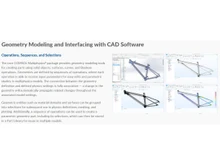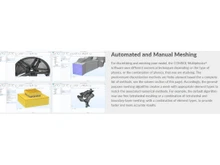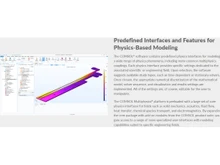Detailed Comparison Guide for COMSOL vs Ansys
When it comes to advanced simulation software used extensively in engineering, research, and product development, COMSOL Multiphysics and ANSYS are two of the most powerful leaders. Both provide exceptional capabilities for modeling complex physical phenomena, but differ in focus, usability, and specialization.
This comprehensive guide provides a clear overview, detailed comparisons, SWOT analysis, and use case recommendations to help engineers, researchers, and organizations decide which best fits their needs.
Overview: COMSOL and Ansys
- COMSOL Multiphysics is a versatile simulation platform that allows users to couple multiple physics phenomena into a single model. This engineering software provides an intuitive UI and a flexible environment where users can customize equations and easily handle interactions like thermal-stress, fluid-structure interactions, and electromagnetics within one framework.
- ANSYS is an industry-leading simulation suite with specialized modules for finite element analysis (FEA), computational fluid dynamics (CFD), electromagnetic simulation, and more. It excels in high-fidelity, domain-specific simulations with robust pre-/post-processing tools, widely used across aerospace, automotive, and electronics sectors.
Core Feature Comparison between Ansys and COMSOL
| Features |
COMSOL Multiphysics |
ANSYS |
| Primary Focus |
Seamless multiphysics coupling |
Dedicated high-accuracy domain-specific simulation |
| User Interface |
Intuitive, flexible, user-friendly |
More complex, steeper learning curve |
| Customization |
High; define custom physics equations |
Moderate; scripting via APDL/Python |
| Solver Efficiency |
General-purpose, evolving GPU acceleration |
Highly optimized domain-specific solvers |
| Multiphysics Integration |
Core design—multiple physics solved simultaneously |
Modular approach—link separate specialized tools |
| Industry Use Cases |
Academic, research, chemical processes, renewable energy, biomedical |
Aerospace, automotive, heavy industry, electronics |
| Platform Support |
Windows, macOS, Linux |
Primarily Windows |
| Simulation Types |
Structural, thermal, fluid, electromagnetic |
FEA, CFD, electromagnetics, thermal, mechanical |
| Pricing |
Price on request |
Price on request |
Multiphysics Capabilities
COMSOL’s strength lies in its seamless multiphysics capabilities, where users can combine diverse physics in a single simulation environment without switching software or linking modules externally.
ANSYS employs a modular approach, where domain-specific tools (e.g., Fluent for CFD, Mechanical for FEA) are linked together for multiphysics but often require data transfer between applications. This makes it less integrated but more powerful for large-scale domain-specific tasks.
User Interface and Learning Curve
COMSOL’s graphical interface is intuitive and more inviting for researchers and academic users, reducing the barrier to experimenting with complex coupled physics.
ANSYS, while rich in features, has a steeper learning curve, better suited for experienced engineers familiar with simulation environments and language-based scripting.
Scripting and Customization
COMSOL supports scripting via MATLAB and Java, with a built-in interface to define custom physics equations tailored to novel research needs.
ANSYS supports automation and customization primarily through ANSYS Parametric Design Language (APDL) and Python scripting, useful for automating complex workflows in large-scale simulations.
Solver Efficiency and Scalability
ANSYS’s solvers are highly optimized for performance, scaling efficiently across HPC systems, enabling very large simulations with industry-grade accuracy.
COMSOL’s solvers are general-purpose and continue improving with recent GPU acceleration updates. Although large-scale or highly specialized industrial problems may run more slowly compared to ANSYS’s specialized modules.
SWOT Analysis: ANSYS vs COMSOL Multiphysics
| Basis |
COMSOL Multiphysics |
ANSYS |
| Strengths |
Intuitive UI and flexible multiphysics coupling.
Cross-platform support.
Affordable for research.
Equation customization. |
Industry-standard solvers optimized for accuracy.
High fidelity for aerospace and automotive.
HPC scalability and automation tools. |
| Weaknesses |
Slower on large-scale specialized problems.
Less domain-specific tooling.
Limited HPC capabilities. |
Steep learning curve.
High cost.
Windows-centric. |
| Opportunities |
Expand HPC and GPU acceleration.
Broaden industry-specific toolkits.
Enhance real-time multiphysics coupling.
Improve user interface for newcomers. |
Expand cross-platform support.
Develop AI-assisted simulation tools. |
| Threats |
Competition from specialized commercial solvers.
ANSYS dominance in industry.
Open-source alternatives growing. |
Balancing complexity and usability.
Cost barriers for smaller teams.
Emerging multiphysics platforms. |
When to Choose COMSOL or Ansys?
| Industry Applications |
COMSOL Multiphysics |
ANSYS |
| Research & Academia |
Widely used due to its flexible Multiphysics. |
Less common and more focused on industrial simulation. |
| Aerospace & Automotive |
Limited to high-end CFD/FEA. |
Extensive use for aerodynamics, structural analysis, and electromagnetics. |
| Biomedical Engineering |
Strong in coupling biological and physical systems. |
Moderate, usually through specialized modules. |
| Chemical Process Simulation |
Highly suitable. |
Used, but not the core focus. |
| Renewable Energy |
Advanced multiphysics modeling. |
Used for performance and structural evaluation. |
| Electronics & Electromagnetics |
Good for integrated Multiphysics. |
Leading tools for electromagnetic simulation (HFSS). |
Choose COMSOL Multiphysics if you:
- Need to model coupled multiphysics phenomena within one seamless platform.
- Are in academic or research settings requiring customization of equations.
- Want an intuitive interface that helps reduce setup time and learning barriers.
- Require cross-platform support (macOS, Linux).
- Have a limited budget but complex multiphysics simulation needs.
Choose ANSYS if you:
- Require high-fidelity, domain-specific simulations for aerospace, automotive, or electronics industries.
- Need scalable HPC-ready solvers for large-scale engineering analysis.
- Prefer a modular environment with specialized solvers optimized for distinct physics.
- Work in industrial or enterprise environments where certified workflows and extensive support are critical.
- Can invest in more expensive licensing for top-tier simulation power.
Techjockey Verdict
Both COMSOL and Ansys offer world-class simulation solutions, but excel in different arenas. COMSOL Multiphysics serves innovation through ease of use, flexibility, and multiphysics coupling, making it the go-to for research and academic environments.
In contrast, ANSYS leads in precision, scalability, and industry penetration, especially where simulation fidelity and performance are critical for product development cycles. Making the right choice depends heavily on your project complexity, budget, required physics, and collaboration needs.
Many organizations leverage both tools according to project stage and specific domain requirements. For tailored recommendations, workflow integration strategies, or licensing advice on Ansys or COMSOL, or any other engineering design software, contact our software experts!


 6 Ratings & 0 Reviews
6 Ratings & 0 Reviews




















